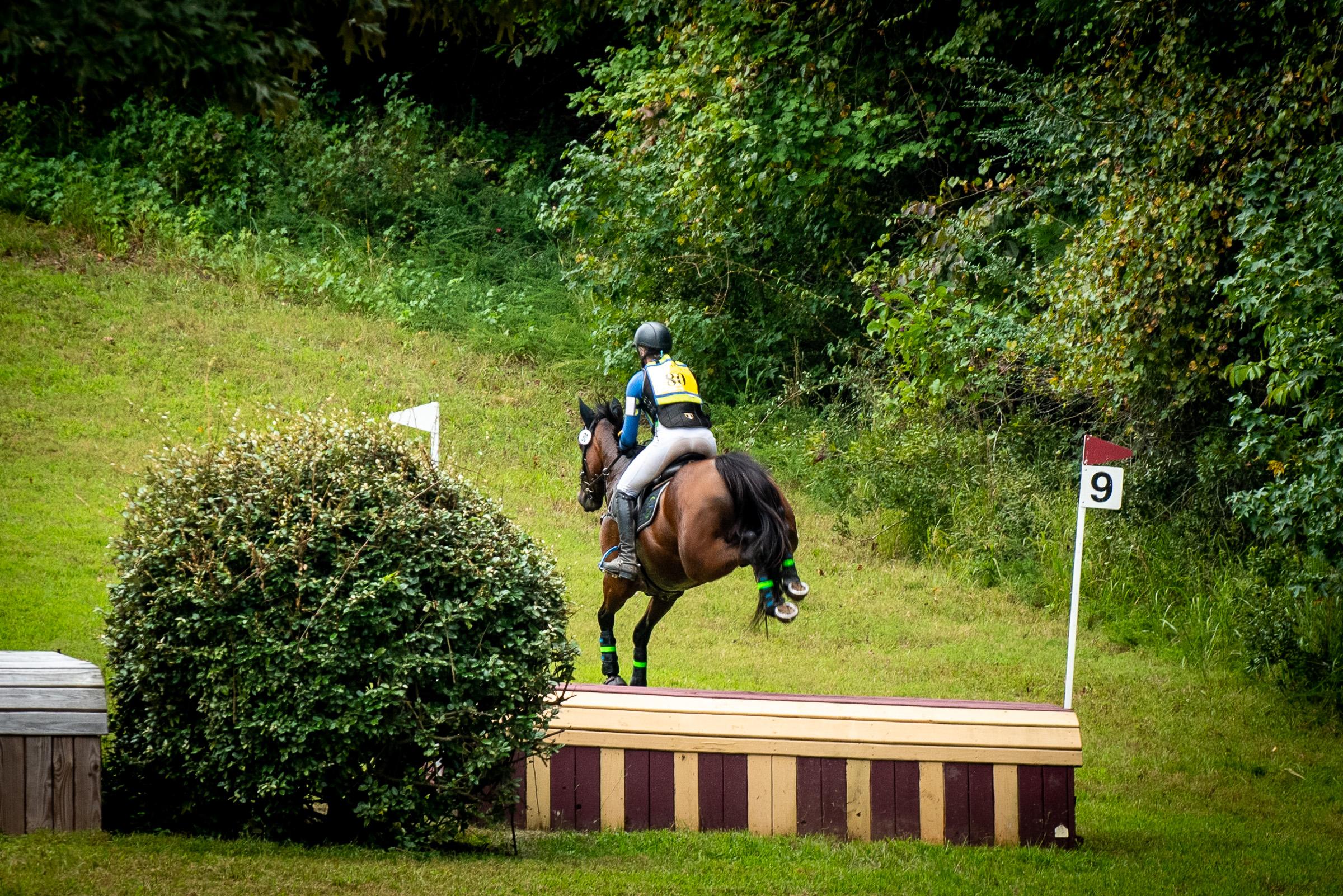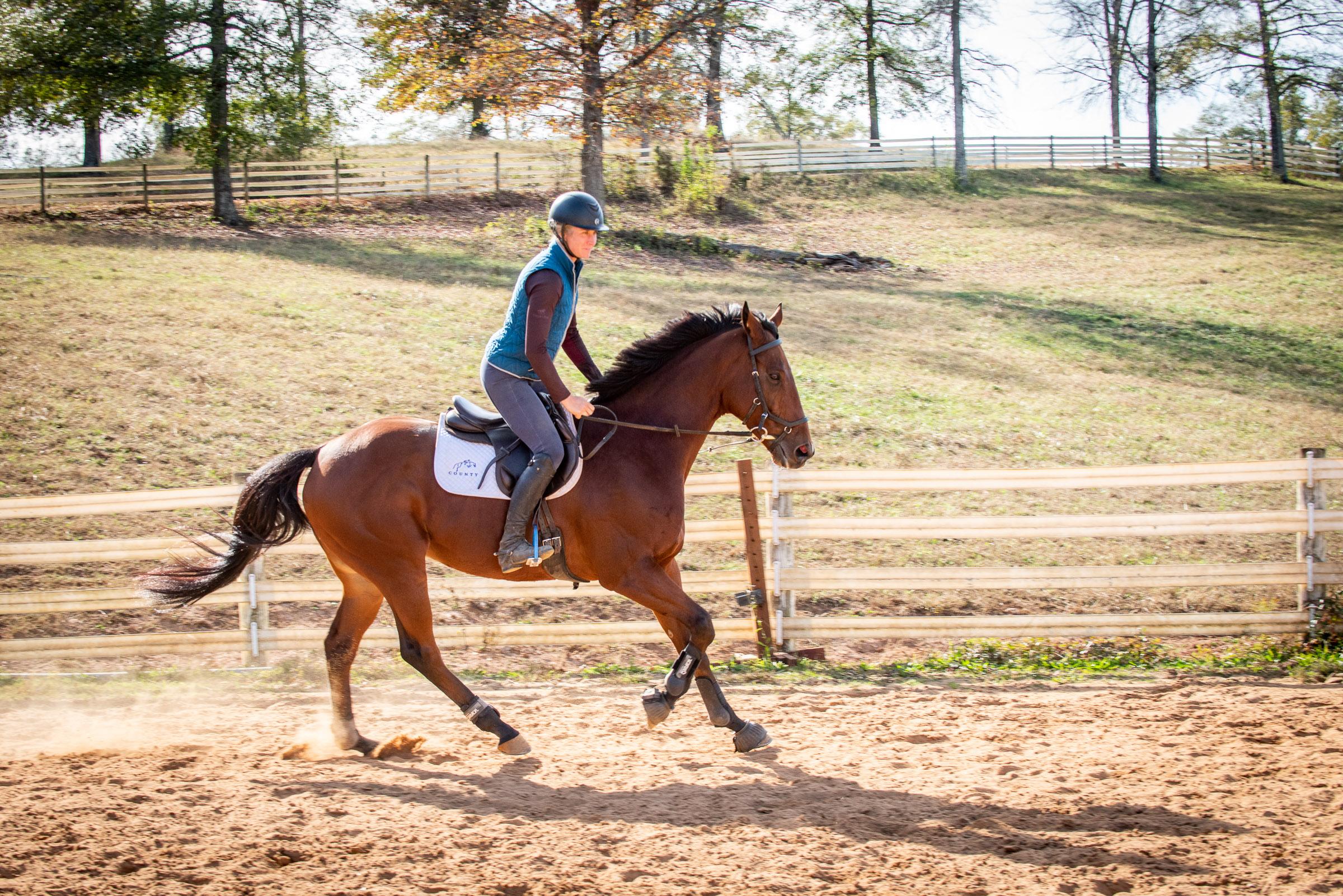
Thoroughbred Logic: The Starter Kit
“So according to me (from the point of view of an Eventer making sweeping statements), here’s a ‘where to skimp, where to focus’ on the ins-and-outs of getting started and getting on regarding tack.”
Welcome to the next installment of Thoroughbred Logic. In this weekly series, Anthropologist and trainer Aubrey Graham, of Kivu Sport Horses, offers insight and training experience when it comes to working with Thoroughbreds (although much will apply to all breeds). This week, come along for the ride as Aubrey discusses her logic on the equestrian starter kit.
This article applies to pretty much all breeds and disciplines — hot horses, slow horses, jumping horses, dressage horses, western horses… whatever. Sure, it is a post about mostly English tack and references the types of things that I love to use on my Thoroughbreds, but more than that, it is a post about not squashing dreams.
It is that time of year when the race meets are ending, winter is coming (or already here), and the price of horses usually reduces for just a moment (at least in some markets). And well, every kid (and adult who never quite grew up) wants the pony under the Christmas Tree. But getting the horse and getting the horse going can be two different things.

This goofball of a cross country machine (Forrest – Don’t Noc It) didn’t get retrained with the fanciest of tack. I’m pretty sure he doesn’t know the difference. Photo by Anna Sasser.
Inspired by a close friend who is unfortunately too many states away for me to drag into my barn and pile with my stuff (though a box is on the way), this post is a prioritizing post. Because folks, for all of you staring down the expensive, complicated situation of bringing a horse along on a budget, I’m going to stand here and tell you that you can absolutely do it. And, better yet, you can do it well without all the bells and whistles.
Horses are expensive. That pretty much goes without saying. Yes, yes, it is not just purchase price, or cost of board, or the rate of good hay, or vet bills (oh, the vet bills…), but it is all the stuff that they need. Boots, bridles, bits, saddles, pads, girths, shoes, trailer, truck, then bigger trailer and bigger truck, and a friend, and then another friend and so on.

One horse leads to two horses, leads to three horses, leads to… I stopped counting. Rhodie, Louis, and Boomer (when he was in training) pictured here at a Big Cheese Eventing Jumper show in the spring. Photo by the Kivu Team.
I look around at the chaos that is my tack room right now and realize just how much “stuff” I have accumulated. When I started out, there was just a plastic endurance bridle, single joint full-cheek snaffle, old metal stirrups, flat 1980s Pessoa, and a fuzzy saddle pad and cheap half pad. I borrowed the rest and was gifted a ton. And you know what? I didn’t have the trendiest get ups, and it was fine. Forrest got trained and to date he is probably the most “broke” horse in the barn. Also the most annoying… but that’s another story.
Over time, I have upgraded my tack as necessary. Though a good hunter friend and mentor made sure that green endurance bridle was whisked away from light of day right quick. But to think about starting from scratch and realizing just how much STUFF you need, makes the whole process feel damn near impossible. So according to me (from the point of view of an Eventer making sweeping statements), here’s a “where to skimp, where to focus” on the ins-and-outs of getting started and getting on regarding tack:
Skimp:
(Let me caveat this section by saying that all gear needs to be safe and each horse and rider will have different needs). Shoestring budgets don’t really exist in the horse world, but knowing where to go top-of-the-line and where to go check Amazon or a used tack store sometimes is helpful.)
Lunging Gear
While the newest lunging cavesons, Pessoa systems and surcingles with side reins are legitimately stunning and quite useful, basic work can be done well with a rope halter and a lunge line. When the goal is to ground train your horse enough to get on, the fancy training gear can come later. You also don’t need a round pen or lunging arena to make this work. I just find a clear spot in the arena and start small (see lunging article here).
Boots
Good bell boots will absolutely save your wallet in the event that they keep pulling shoes, but unless the horse is interfering and hitting themselves, schmancy jump or dressage boots aren’t always necessary to get started. They are necessary additions and kind to the horse when you start doing more extensive, intensive work, but they’re not essential, UNLESS your horse needs them.

Rhodie (Western Ridge) showing off his scope and his need for cross-country boots. (Boots are great on XC at all levels, but once they’re running BN or above, they absolutely get leg protection). Photo by Cora Williamson.
Bridle
I love my Mikelem bridles, but I would be just as happy to hack almost any of my horses here in a simple snaffle bridle. So long as the leather is decent quality (aka not breaking) and it fits (is not so small that the throat latch is flush with, well, the throat, or so large that the noseband bounces when on the last hole), I’d say run with it. The pretty anatomic bridles with proper padding and the like are lovely. In fact, some of them downright look like works of art. But, as with most things, upgrading there can come later.
Bits
The soft flexibility of the Herm Springer Duos make my young Thoroughbreds happy to seek contact, but at around $100 a pop, no one absolutely needs to start there. Instead, for $30 there are double jointed loose ring and eggbutt snaffle Korsteel bits that honestly do a completely fine job. The same goes for reins. I’m particular to a certain set of rubber reins, but the old laced leather variety are totally fine even if not crazy trendy (in the eventing world).

Monk (Sydster) shows off his Mikelem and Herm Springer Duo — a fabulous combination for green Thoroughbreds, but there are absolutely more affordable ways to do nearly as well. Photo by Kelly Robison.
Saddle Pads
Oh, the matchy-matchy craze. Do you need the prettiest, plushest, matching set with fuzz somewhere? Nopelope. Do you need something that will not bunch under your saddle and will keep your horse comfortable while you ride? Yes. That one should be easy to satisfy, and I’m sure every used tack store or online market place has heaps of them on the cheap.
Girths
These are middle ground. I do prefer girths (like the Prolite or Tapestry Comfort girths) that give in all the right places, but for a while you can absolutely get by with a basic neoprene or leather girth so long as the buckles aren’t rusty and the elastic still works. The biggest thing here is about safety — if your saddle isn’t staying snug because of the girth, that becomes a worrisome thing and you might need an upgrade. Same goes for stirrups — average is just fine until you feel yourself struggling to stay in them, slipping, or having joint pain, then time to think about upgrades.

I have been loving how my horses go in the Tapestry Comfort girth, but when starting out, an average neoprene one is just fine by me. Photo of new sales horse, Bayou Gem, on his first post-track ride by Alanah Giltmier.
Where to invest:
Basically, my version of where the money needs to go first is to making sure that you and your new horse are safe and comfortably able to go train. Most of this then focuses around the saddle.
Saddles
If you need a saddle, you ought to make sure it is the right one… or at least close enough for now. I can’t tell you how many saddles I have seen that not only don’t fit their horses, but also actively work against the rider’s best intentions by putting pressure on the shoulders or withers, pinching, or simply tipping the human out of a safe and comfortable position. A poorly fitting saddle can cause your horse to behave like more of a clown than just the usual fresh off-the-track circus pony.

Crafty Charger is one horse who always makes me happy to be in good-fitting tack. This reactive goober always tests my seat. Photo by Amanda Woomer.
While working alongside my saddle fitter (ahem Cindy Adcock and County Saddles) I hear folks comment regularly that once their horse is done growing, or is finally running a certain level, they will invest in a saddle. Here’s the thing — if you have the ability to invest in the future, might as well do so now. Starting a horse in tack that, at a bare minimum, fits is one of the best gifts you can give your horse. I don’t care if the saddle is old or if it isn’t a fancy brand. If it is wool flocked, get it reflocked for the horse. If you have questions about its fit or viability, phone a trainer friend or, better yet, get a knowledgable fitter out.
Half-Pads
If you need a half-pad to make the saddle fit the horse, that’s the other place I don’t recommend skimping. Poorly made or bulky half-pads can undermine the comfort of the horse. While Thin Lines and Prolite pads are expensive, the material their shims are made of rebounds quickly. I have yet to see a horse go badly in any of those. And if a good half-pad gets the older, not-quite-perfect saddle to fit well enough for now, that can buy you time to save up for the new-to-you saddle that makes you and your horse feel that much more comfortable.

Quality Step packing around in my MN County xcelerator and Prolite half-pad on his third ride post track. Photo by Kelly Robison.
Experience and quality care
But finally – where else ought one spend all the money? Experience and quality care. Make sure your horse has a properly good farrier and vet, and that you are getting the lessons you need from a trainer that makes sense and understands your goals. More than your tack, the quality of care and instruction will make the difference.
So if you’re looking at the journey to having your own horse and feeling like it is impossible, I can promise you it is not. Buy the horse, invest in safe equipment, get the experience, and most importantly, go have fun. Despite all the stress and worry and self doubt, that — that concept of “fun” — is actually at the heart of why swing up and kick on.






